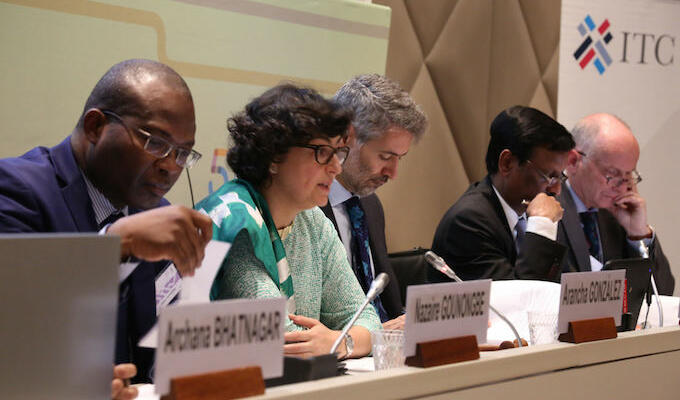

ITC highlights SME trade costs at WTO Aid for Trade Review
Leveraging development aid to cut the costs to small businesses of participating in international trade was the common thread running through ITC’s interventions today at the World Trade Organization’s Fifth Global Review of Aid for Trade.
Reducing trade costs for inclusive and sustainable growth is the theme of the WTO’s biennial review of trade-related development assistance, which runs from 30 June to 2 July at the global trade body’s headquarters in Geneva.
ITC was an active participant at the first day of the event, organizing a side event to highlight the difficulties that small and medium-sized enterprises (SMEs) face in complying with non-tariff measures (NTMs) and related policies. Two publications were launched, one documenting the results of ITC’s business surveys on NTMs in 23 countries, and the other on reducing trade costs for SMEs. The latter figured in this year’s edition of ‘Aid for Trade at a Glance’, a biennial report by the WTO and the Organization for Economic Co-operation and Development (OECD).
Senior ITC representatives also participated in various sessions, calling participants’ attention to how targeted Aid for Trade and private sector action could make it less expensive for developing country SMEs – which account for the majority of firms and the bulk of employment – to connect to international markets.
Higher trade costs mean lower trade flows, and thus limit trade’s potential to drive economic growth, job creation, and the reallocation of resources towards more productive activities within developing economies. The reasons for high trade costs vary, from geographic isolation and poor infrastructure to outdated border facilities and needlessly complex policies. Whatever the reason, World Bank research shows that trade costs are highest in the poorest countries – the very countries most in need of growth.
It is not just the most vulnerable countries that are affected. As ITC Executive Arancha González noted at the Aid for Trade Review’s opening session, trade costs fall particularly heavily on SMEs, for which fixed costs by definition account for a larger part of unit costs than they do for their larger competitors. “High trade costs can keep SMEs out of international markets,” she said.
Observing that limiting SMEs to their home markets meant foregone opportunities to generate broad-based employment and productivity gains, she called for action to reduce the cost of complying with non-tariff measures, to simplify the increasingly complex market for private sustainability standards, and to lower border costs by implementing the WTO Trade Facilitation Agreement.
ITC’s chief economist, Marion Jansen, sounded similar notes at a session on how public-private cooperation, both to inform policymaking and as a source of financing, can contribute to sustainable and inclusive growth. Surveys revealed that the single biggest factor holding back SMEs from exporting was insufficient access to information about what to sell and where, as well as how to meet market requirements. But expensive trade finance, and the certification costs associated with crucial standards, can also keep SMEs out of regional and international markets. Jansen said that intermediary institutions, like chambers of commerce and trade promotion agencies, can play a critical role in helping dynamic SMEs overcome these bottlenecks.
Non-tariff measures, which by some estimates impose costs on traders equivalent to 20 to 30% of the value of the goods being exchanged, were the subject of an ITC side event on reducing costs for business. While often necessary to safeguard consumer safety or other public policy objectives, NTMs can be needlessly complex and expensive to comply with.
At the event, exporters from India and Thailand shared their own experiences with product standards and certification requirements, in both their home and export markets. Archana Bhatnagar, the owner of Haylide Chemicals, which makes green cleaning products in India, described how the lack of an up-to-date domestic environmental standard meant that some of her company’s products struggled to differentiate themselves from more polluting competitors. Meanwhile, to maintain approval from US sanitary authorities, another product – used to clean toilets – had to undergo a level of scrutiny normally reserved for pharmaceutical products. Chusak Chuenprayoth, the president of KC Fresh, a Thai fruit and vegetable exporter, noted that some export certification costs in Thailand are higher even than in the United Kingdom. Both called for closer public-private cooperation to better respond to SMEs’ needs.
Senior officials from Cote d’Ivoire and Mauritius described how ITC’s business surveys on trade obstacles linked to NTMs helped them design policies to reduce trade-related costs and delays for SMEs. Representatives from the European Union and the UK, meanwhile, highlighted the importance of reducing SME trade costs for job creation and poverty reduction.
In addition to the ‘Invisible Barriers to Trade’ publication, ITC used the session to launch a new website presenting the results of the NTM surveys.



